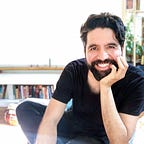Building the Design Ecosystem of the Future
Why I’m joining InVision
I’m happy to share that I have joined the InVision team to work on the Studio Platform. We aim to build the most connected design ecosystem enabling teams to navigate through every stage of the design process, from ideation to development.
The evolution of design tools
Over the past few years, the role of the modern designer has evolved at an incredible pace. Alongside with it so has the perception. What was once perceived as someone who creates pretty pixels has shifted to the person who applies research, creates experiences, adds interactions, and joins leadership by having a voice for the companies users.
As a result of this rapid shift, a slew of new responsibilities have been shifted onto designers. Advancements in technology have required designers to design for various contexts, devices, and languages. What was once a static pixel, is now a dynamic unit that adopts, grows, shrinks, and animates. We now transform ideas into concepts, sketches, wireframes, screens, flows, prototypes, animation, code, and finally into products.
In parallel with this evolution, design tools have evolved to support these specific needs. This includes everything from tools specially built to create screen designs and interactive prototypes to plugins that give your document responsive layouts, enable design hand-off, and support real-time collaboration.
It has been exciting to see such a diverse collection of tools emerge, but this has ultimately led to uncertainty for the designer, and in many cases, a broken design workflow. 💔
Learning to become a designer
Four years ago I made the transition from Graphic Designer to “Product Designer.” I have to be honest, I didn’t know what the hell a product designer was. But it seemed pretty straightforward. It was just drawing a ton of boxes, adding text, and aligning everything to the left, right?
Oh, I was wrong. Product design involved way more than that. There was a process to follow, methods to implement, people to team up with, and tools to use. Back then, there weren’t a lot of learning resources and we treated the scarce Medium posts written by design leaders as gospel. 🙏🏽
In the middle of all this evolution, more and more resources began to appear, making the path to becoming a product designer a bit easier. Meng To’s Design+Code taught us how to use the necessary tools, and uxdesign.cc gave us an inside look at what user experience was. I decided to join them and share with other designers what I was learning along the way. I started giving design workshops in the Bay Area and created a YouTube channel full of tutorials.
In order to learn how to be a better product designer, I decided that I was going to teach how to be a product designer. Sounds counterintuitive, right? But it kind of makes sense. Trying to show something forces you to deeply understand it so you can break it down and explain it.
Sharing what I’ve learned has exposed me to a fantastic community of makers. People thirsty for knowledge, powered by an incredible creative force, who openly share back what they learn. I have been blessed to be part of this incredible group.
My next step in this journey is to go from someone that teaches people how to use design tools into joining a team that creates design tools for them.
Why InVision
According to Jim Collins, great companies don’t start with where they’re going, or how they’re going to get there, but with who is joining the ride. They start by getting the right people on the bus—A-level people who are willing to put out A-plus effort. There’s no better example of this than InVision.
I have been in contact with people at InVision over the last couple of years, collaborating on plugins, resources, and just nerding out about design and tools. And while their professionalism and communication has always been excellent, the most astounding thing I’ve noticed is their people. Every person I meet feels like they’re perfect for their role and it shows.
This team has allowed InVision to grow fast and stay on a roll. They have created some of the most beloved design tools like Craft, Design System Manager, Design Better, Freehand, Inspect, and now Studio—a screen design tool for the modern designer. Joining such a great team will be a learning experience. I can’t wait to work side by side with some of the most talented designers and smart product people that I admire. 🙌🏽
The design tool for all
What if everything you needed to create amazing experiences lived in the same design ecosystem? Sounds like the holy grail, right? With the launch of Studio Platform, this will soon be possible. I’m joining a team that will be collaborating with third-parties to help them deliver high-quality experiences. We’ll help bring design assets and resources for the top applications. And we’ll be reaching out to the community to understand their needs and help them onboard to our platform.
We’re building a team of engineering, design, and marketing support for the platform. Besides, we’re putting our money where our mouth is—the Design Forward Fund is offering $5 million in grants and equity investments to people and companies who are creating world-class apps and add-ons for InVision Studio. I envision a healthy ecosystem built and pushed by a community of makers. If you have a great idea for an app that could improve the design workflow inside Studio, we want to hear it! 📣
I’m thrilled to be joining InVision as the design lead on our platform. We invite you, makers, developers, and entrepreneurs, to join us in making this dream come true—building the design ecosystem of the future.
BTW, all of the animations in this post were made using Studio. You can download them here.
Thanks to Courtney M. Sawyer, Edgar Chaparro, and Lindsey Scott for helping me fix all my grammatical horrors.
